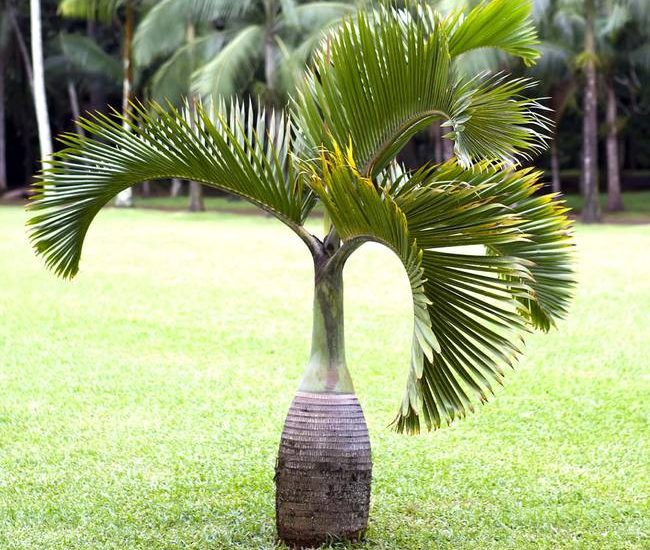Are There Palm Trees in New Mexico? Exploring the State’s Flora
New Mexico is a state located in the southwestern region of the United States. It is known for its diverse landscapes, ranging from deserts to mountains to forests. However, one question that often arises is whether or not there are palm trees in New Mexico.

Palm trees are often associated with warm, tropical climates, and it is true that they are commonly found in places like Hawaii and Florida. However, they can also be found in other areas with similar climates. New Mexico has a predominantly arid climate, with hot summers and mild winters. This may lead some to believe that palm trees could potentially grow in the state.
The environment of New Mexico is unique and can vary greatly depending on the region. The state is home to a variety of plant and animal species, many of which are adapted to the desert climate. While palm trees are not typically associated with desert environments, there are some species that can tolerate dry conditions. This raises the question of whether or not any palm trees can be found in New Mexico.
Climate and Geography of New Mexico

New Mexico is a state located in the southwestern region of the United States. It has a diverse geography, ranging from high mountains to deserts. The state is known for its arid and semi-arid climate, which is influenced by its high altitude and proximity to the desert.
Temperature Variations
New Mexico experiences a wide range of temperatures throughout the year. Winters can be cold, with temperatures dropping below freezing in some areas. Summers can be hot, with temperatures reaching over 100 degrees Fahrenheit in some parts of the state. However, due to the state’s high altitude, temperatures can drop quickly at night, even during the summer months.
Arid and Semi-Arid Zones
New Mexico is classified as a desert state due to its low precipitation levels. The state receives an average of 13 inches of rainfall per year, with some areas receiving even less. The majority of the state is considered to be in an arid or semi-arid zone, which means that it experiences long periods of drought. This can have a significant impact on the state’s agriculture and natural resources.
Overall, New Mexico’s climate and geography create a unique environment that is both challenging and beautiful. Despite its arid conditions, the state is home to a variety of plant and animal species, including several types of cacti and palm trees in certain areas.
Palm Trees in New Mexico
New Mexico is known for its arid climate and desert landscape, but are there palm trees in this state? The answer is yes, there are a few species of palm trees that can thrive in New Mexico’s climate.
Species Able to Thrive
The European fan palm, also known as the Mediterranean fan palm (Chamaerops humilis), is one of the most cold-hardy palm trees and can survive in New Mexico’s hardiness zones 7-10. It can tolerate temperatures as low as 5°F and is drought-tolerant, making it an ideal choice for this region.
Another palm tree that can thrive in New Mexico is the Pindo palm (Butia capitata). This palm tree is hardy to zone 8 and can tolerate temperatures as low as 5°F. It is also drought-tolerant and can grow up to 20 feet tall.
The Sago palm (Cycas revoluta) is another option for New Mexico. This palm tree is not a true palm, but it has a similar appearance. It is hardy to zone 8 and can tolerate temperatures as low as 15°F. However, it is important to note that the Sago palm is toxic to pets and humans if ingested.
Cultivation Challenges
While some palm trees can thrive in New Mexico, there are also some challenges to cultivating them in this region. One of the biggest challenges is the lack of water. Palm trees require regular watering, and New Mexico’s arid climate can make it difficult to keep them hydrated.
Another challenge is leaf scorch, which can occur when palm trees are exposed to hot, dry winds. To prevent leaf scorch, it is important to plant palm trees in a location that is sheltered from the wind.
Overall, while palm trees may not be the most common sight in New Mexico, there are a few species that can thrive in this region’s climate. By selecting the right species and taking proper care, it is possible to add a touch of tropical flair to your New Mexico landscape.
Landscaping with Palm Trees

Palm trees have long been associated with tropical regions, but they can also be grown in regions with a mild climate. New Mexico, located in the southwestern region of the United States, is known for its arid climate and unique landscape. While palm trees are not native to New Mexico, they can be cultivated in the region with proper care and maintenance.
Private and Public Spaces
Palm trees can be a great addition to both private and public spaces in New Mexico. In private gardens, they can add a touch of tropical flair to the landscape. In public spaces such as parks, they can provide shade and a relaxing atmosphere for visitors.
One example of a public space in New Mexico that has successfully incorporated palm trees into its landscape is the ABQ BioPark in Albuquerque. The park features a variety of palm trees, including the Mexican Fan Palm and the Mediterranean Fan Palm, which thrive in the region’s dry climate.
Care and Maintenance
Proper care and maintenance are crucial for the successful cultivation of palm trees in New Mexico. One important factor to consider is sunlight. Palm trees require a lot of sunlight to thrive, so it is important to plant them in an area that receives plenty of direct sunlight.
Another important factor to consider is vegetation. Palm trees require well-draining soil and should be planted in an area with minimal competition from other plants. Regular watering and fertilization can also help promote healthy growth.
In Las Cruces, the city’s Parks and Recreation department has successfully incorporated palm trees into its parks and public spaces. The department emphasizes the importance of proper care and maintenance to ensure the longevity of the trees.
Overall, while palm trees are not native to New Mexico, they can be cultivated in the region with proper care and maintenance. With their ability to add a touch of tropical flair to the landscape and provide shade and relaxation, palm trees can be a great addition to both private and public spaces in the region.
Cultural and Economic Impact

Local Uses of Palm Trees
Palm trees are not native to New Mexico, but they have been introduced to the state as ornamental plants. They are often planted in residential and commercial landscapes, as well as in public parks and along streets. However, they do not have any significant local uses in terms of food or traditional crafts.
Palm Trees in Local Economy
Although palm trees do not play a major role in the local economy of New Mexico, they do have some economic impact. The tourism industry, in particular, benefits from the presence of palm trees in certain areas of the state, such as Truth or Consequences and Santa Fe. These trees provide an exotic and tropical feel to the landscape, which can attract visitors looking for a unique experience.
Additionally, some businesses in New Mexico, such as nurseries and landscaping companies, may sell or use palm trees as part of their products or services. However, the demand for palm trees in the state is relatively low compared to other regions, such as California or Florida.
It is worth noting that the Joshua tree and junipers are more commonly associated with the flora of New Mexico than palm trees. These native plants have a more significant cultural and economic impact on the state, as they are used for food, medicine, and traditional crafts by locals and tourists alike.


